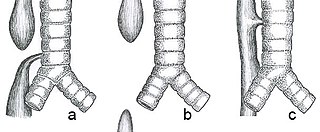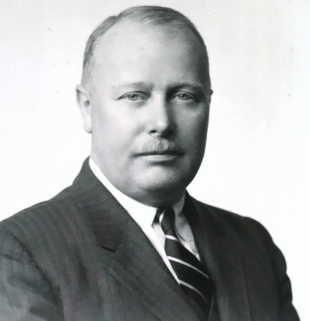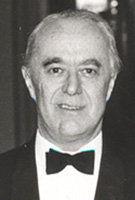Related Research Articles

Esophageal atresia is a congenital medical condition that affects the alimentary tract. It causes the esophagus to end in a blind-ended pouch rather than connecting normally to the stomach. It comprises a variety of congenital anatomic defects that are caused by an abnormal embryological development of the esophagus. It is characterized anatomically by a congenital obstruction of the esophagus with interruption of the continuity of the esophageal wall.

A tracheoesophageal fistula is an abnormal connection (fistula) between the esophagus and the trachea. TEF is a common congenital abnormality, but when occurring late in life is usually the sequela of surgical procedures such as a laryngectomy.

Pediatric surgery is a subspecialty of surgery involving the surgery of fetuses, infants, children, adolescents, and young adults.

A gastrostomy is the creation of an artificial external opening into the stomach for nutritional support or gastric decompression. Typically this would include an incision in the patient's epigastrium as part of a formal operation. When originally devised over a century ago the procedure was completed through open surgery using the Stamm technique. It can be performed through surgical approach, percutaneous approach by interventional radiology, percutaneous endoscopic gastrostomy (PEG) or percutaneous ultrasound gastrostomy (PUG).
Atresia is a condition in which an orifice or passage in the body is closed or absent.

Intestinal atresia is any congenital malformation of the structure of the intestine that causes bowel obstruction. The malformation can be a narrowing (stenosis), absence or malrotation of a portion of the intestine. These defects can either occur in the small or large intestine.

A hepatoportoenterostomy or Kasai portoenterostomy is a surgical treatment performed on infants with Type IVb choledochal cyst and biliary atresia to allow for bile drainage. In these infants, the bile is not able to drain normally from the small bile ducts within the liver into the larger bile ducts that connect to the gall bladder and small intestine.
Aortopexy is a surgical procedure in which the aortic arch is fixated to the sternum. It results in the tracheal lumen being pulled open. It is used to treat severe tracheomalacia or tracheal compression.
Esophagogastric dissociation is a surgical procedure that is sometimes used to treat gastroesophageal reflux, mainly in neurologically impaired children. It has been suggested as an alternative to Nissen fundoplication for these cases. Preliminary studies have shown it may have a lower failure rate and a lower incidence of recurrent reflux.

Jane Somerville is a British emeritus professor of cardiology, Imperial College, who is best known for defining the concept and subspecialty of grown ups with congenital heart disease (GUCH) and being chosen as the physician involved with Britain's first heart transplantation in 1968.
Saroj Chooramani Gopal, is an Indian medical doctor, medical educationist and considered as the first woman M.ch paediatric surgeon from All India Institute of Medical Sciences, New Delhi in the country. She is currently the President, National Academy of Medical Sciences (India). She was honoured by the Government of India, in 2013, by bestowing on her the Padma Shri, the fourth highest civilian award, for her contributions to the fields of medicine and medical education.

Mario Zaritzky is MD, scientist and inventor and currently lives and works as an associate professor of Radiology at Jackson Memorial Center. Previously, he was an assistant professor in the Department of Pediatric Radiology Department of Radiology, University of Chicago in Chicago, Illinois, USA. Zaritzky coordinated the Argentine Network of Science in Midwestern, United States, from the Ministry of Science, Technology and Productive Innovation Programme of Argentina.

Morio Kasai was a Japanese surgeon who had a strong interest in pediatric surgery. While Kasai went into practice at a time when pediatric surgery was not an established subspecialty, much of his clinical and research work was related to the surgical care of children. He is best known for devising a surgical procedure, the hepatoportoenterostomy, to address a life-threatening birth defect known as biliary atresia. The modern form of the operation is still known as the Kasai procedure.

Orvar Swenson was a Swedish-born American pediatric surgeon. He discovered the cause of Hirschsprung's disease and in 1948, with Alexander Bill, performed the first pull-through operation in a child with megacolon, which then became a treatment for the disease.

Isabella Forshall FRCSE was an English paediatric surgeon who played a leading role in the development of the speciality of paediatric surgery in the United Kingdom. She took a particular interest in neonatal surgery and was instrumental in the establishment of the Liverpool Neonatal Surgical Unit, the first neonatal intensive care unit in the UK and indeed in the world.

James Johnston Mason Brown OBE, FRCSEd was a Scottish paediatric surgeon. During World War II he served as a surgical specialist with the 8th Army in North Africa and Italy and was awarded the OBE for this service. As surgeon-in-chief at the Royal Hospital for Sick Children in Edinburgh, he edited the major textbook The Surgery of Childhood. He was the joint founder of the Scottish Surgical Paediatric Society and a founder member of the British Association of Paediatric Surgeons (BAPS), of which he became president. He was elected President of the Royal College of Surgeons of Edinburgh (RCSEd) in 1962 but died in office aged 56 years.
Robert Bransby Zachary was an English paediatric surgeon who spent the majority of his career at Sheffield Children's Hospital. He was an expert on the treatment of spina bifida and hydrocephalus.
Denis Browne Gold Medal is a medal that was first struck in 1968, one year after the death of the paediatric surgeon Denis Browne and is awarded for outstanding contributions to paediatric surgery worldwide and is an honour bestowed by The British Association of Paediatric Surgeons.
Andrea A. Hayes Dixon is an American surgeon. She was the first pediatric surgeon to perform a high-risk, life-saving procedure in children with a rare form of cancer and developed the first orthotropic xenograft model of metastatic Ewing's sarcoma. In 2002, she became the first African American female pediatric surgeon board-certified in the United States.
Leela Kapila is a British Indian surgeon and former consultant paediatric surgeon at the Nottingham University Hospitals NHS Trust. She was awarded the OBE for services to surgery in 1996.
References
- 1 2 3 4 5 6 "Honorary Degree Citations - Emeritus Prof Lewis Spitz - Wits University". University of the Witwatersrand, Johannesburg. Wits University. Retrieved 23 October 2018.
- 1 2 "Emeritus Professor Lewis Spitz". The Royal College of Paediatrics and Child Health. 28 February 2017. Retrieved 23 October 2018.
The team at Great Ormond Street Hospital managed 40 sets of conjoined twins of which 89% survived elective separation. He was the first paediatric surgeon to a study of the psychological consequences of neonatal surgery and of Hirschsprung's disease and anorectal malformations on subsequent development.
- 1 2 3 4 5 6 Schwart, Marshall Z. (8 November 2012). "Citation for Prof. Lewis Spitz, MB, BCh, PhD, FRCS, FRCS(Ed)". General News. Bulletin of the American College of Surgeons. Retrieved 23 October 2018.
- ↑ "Honorary Fellows of the Royal College of Surgeons in Ireland since 1784". Ireland Genealogy Projects Archives. Txt File: Royal College of Surgeons in Ireland. Archived from the original on 3 February 2018. Retrieved 30 October 2018.
- ↑ "Changes during a life time in Paediatric Surgery". UCL Home. Professor Lewis Spitz: University College London. 13 May 2013. Retrieved 30 October 2018.
- ↑ "Fellowship Election and Prize Committee" (pdf). Studylib. The Royal College of Surgeons of England. 3 July 2017. Section 11. Retrieved 30 October 2018.
- ↑ "Denis Browne Gold Medal". British Association of Paediatric Surgeons. Retrieved 25 October 2018.
- ↑ "EUPSA Honoured Persons 2005-2016". 18th Congress of the European Paediatric Surgeons' Association Limassol, Cyprus, 17th-20th May 2017 (pdf). European Paediatric Surgeons’ Association. p. 8. Retrieved 30 October 2018– via Doc Player.
- ↑ "Honorary FAAP Winners". 2012 AAP Award Winners. American Academy of Pediatrics. AAP News and Journals Gateway. 1 October 2012. Retrieved 30 October 2018.
- 1 2 Robert Carachi (2009). A History of Surgical Paediatrics. World Scientific. p. 157. ISBN 978-981-277-228-2 . Retrieved 30 October 2018.